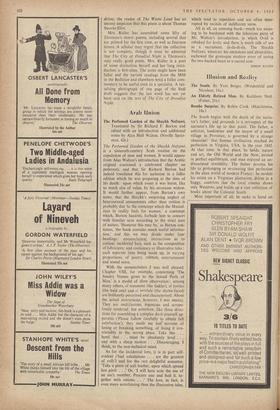Arab Union
The Perfumed Garden of the Shaykh Nefzawi. Translated by Sir Richard F. Burton and edited with an introduction and additional notes by Alan Hull Walton. (Neville Spear- man, 42s.)
The Perfumed Garden of the Shaykh Nefzawi is a sixteenth-century Arab treatise on the copulation of men and women. It would' appear from Alan Walton's introduction that the Arabic original contained a celebrated chapter on pederasty, and that Sir Richard Burton had indeed translated this for inclusion in a fuller edition which he was preparing at the time of his death : upon which event it was burnt, like so much else of value, by his atrocious widow. It would further appear, from Burton's own notes, that the Shaykh's surprising neglect of heterosexual amusements other than coition is probably due `to the contempt which the Mussul- man in reality feels for women,' a contempt which, Burton hazards, forbade him to consort -with females save according to the strict uses of nature. 'However this may be,' as Burton con- tinues, 'the book contains much useful informa- tion,' and this we may divide under four headings: nomenclature; instructions as to coition; incidental lore, such as the composition of lubricants; and cautionary or illustrative tales: each separate item being made up, in varying proportions, of poetry, rubbish, entertainment and sound sense.
With the nomenclature I was well pleased. Chapter VIII, for example, concerning 'The Sundry Names given to the Sexual Parts of Man,' is a model of close observation : among many others, el teunnana (the tinkler), el fortass (the bald one) and el mostahi (the shame-faced) are brilliantly perceived and characterised. About the actual instructions, however, I was uneasy. They are multifarious, ingenious and scrupu- lously rendered; but somehow, like those direc- tions for assembling a complex do-it-yourself ap- paratus ('Please follow carefully to obtain full satisfaction'), they made me fee1.3 nervous of losing or breaking something, of fixing it irre- trievably in the wrong place. Take this . . . bend that . . . must be absolutely level . . . and with a sharp motion . . . Discouraging, I think, to the non-technical mind.
As for the incidental lore, it is in part self- evident (Ind exhalations . . . are the greatest of evils') and for the rest delightful nonsense. 'Take a piece of soft leather, upon which spread hot pitch . . Or, 'I will here note the use of an ass's member., Procure one and boil it, to- gether with onions. . . .' The lore, in fact, is even more entertaining than the illustrative tales, which tend to repetition and are often inter- rupted by recitals of indifferent verse.
All in all, an amusing book—much too amus- ing to be burdened with the laborious piety of Mr. Walton's introduction, in which Ovid is rebuked for levity and there is much talk of sex as a sacrament, di-da-di-da. The Shaykh Nefzawi, whatever his omissions and absurdities, eschewed the grotesque modern error of seeing the two-backed beast as a sacred cow.
SIMON RAVEN










































 Previous page
Previous page